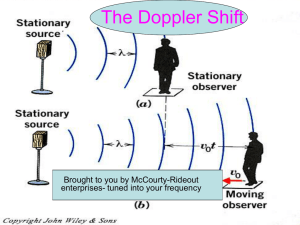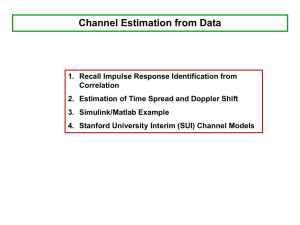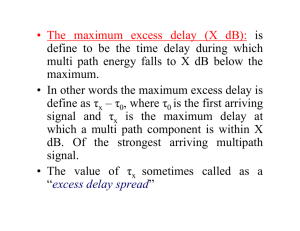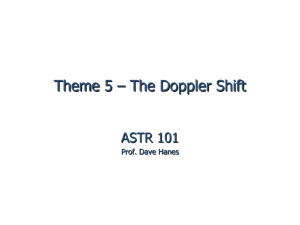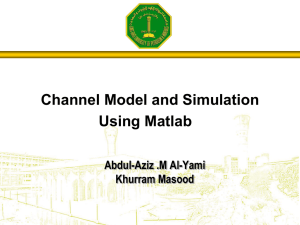International Journal of Application or Innovation in Engineering & Management... Web Site: www.ijaiem.org Email: Volume 3, Issue 3, March 2014
advertisement
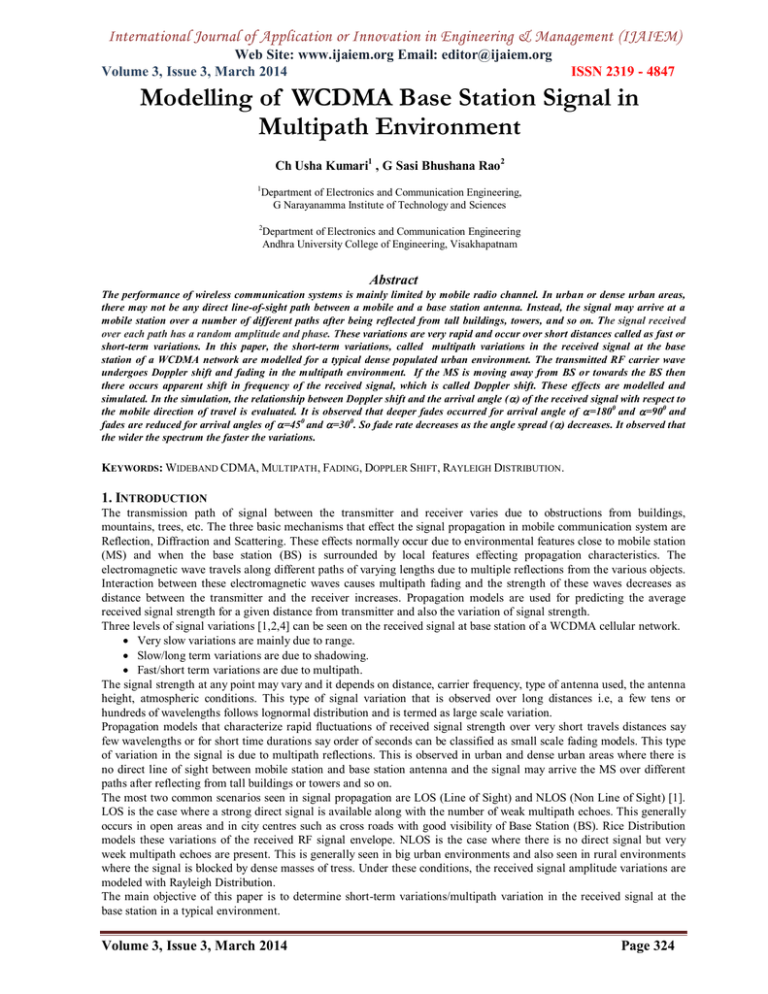
International Journal of Application or Innovation in Engineering & Management (IJAIEM) Web Site: www.ijaiem.org Email: editor@ijaiem.org Volume 3, Issue 3, March 2014 ISSN 2319 - 4847 Modelling of WCDMA Base Station Signal in Multipath Environment Ch Usha Kumari1 , G Sasi Bhushana Rao2 1 Department of Electronics and Communication Engineering, G Narayanamma Institute of Technology and Sciences 2 Department of Electronics and Communication Engineering Andhra University College of Engineering, Visakhapatnam Abstract The performance of wireless communication systems is mainly limited by mobile radio channel. In urban or dense urban areas, there may not be any direct line-of-sight path between a mobile and a base station antenna. Instead, the signal may arrive at a mobile station over a number of different paths after being reflected from tall buildings, towers, and so on. The signal received over each path has a random amplitude and phase. These variations are very rapid and occur over short distances called as fast or short-term variations. In this paper, the short-term variations, called multipath variations in the received signal at the base station of a WCDMA network are modelled for a typical dense populated urban environment. The transmitted RF carrier wave undergoes Doppler shift and fading in the multipath environment. If the MS is moving away from BS or towards the BS then there occurs apparent shift in frequency of the received signal, which is called Doppler shift. These effects are modelled and simulated. In the simulation, the relationship between Doppler shift and the arrival angle ( ) of the received signal with respect to the mobile direction of travel is evaluated. It is observed that deeper fades occurred for arrival angle of =1800 and =900 and fades are reduced for arrival angles of =450 and =300. So fade rate decreases as the angle spread ( ) decreases. It observed that the wider the spectrum the faster the variations. KEYWORDS: WIDEBAND CDMA, MULTIPATH, FADING, DOPPLER SHIFT, RAYLEIGH DISTRIBUTION. 1. INTRODUCTION The transmission path of signal between the transmitter and receiver varies due to obstructions from buildings, mountains, trees, etc. The three basic mechanisms that effect the signal propagation in mobile communication system are Reflection, Diffraction and Scattering. These effects normally occur due to environmental features close to mobile station (MS) and when the base station (BS) is surrounded by local features effecting propagation characteristics. The electromagnetic wave travels along different paths of varying lengths due to multiple reflections from the various objects. Interaction between these electromagnetic waves causes multipath fading and the strength of these waves decreases as distance between the transmitter and the receiver increases. Propagation models are used for predicting the average received signal strength for a given distance from transmitter and also the variation of signal strength. Three levels of signal variations [1,2,4] can be seen on the received signal at base station of a WCDMA cellular network. Very slow variations are mainly due to range. Slow/long term variations are due to shadowing. Fast/short term variations are due to multipath. The signal strength at any point may vary and it depends on distance, carrier frequency, type of antenna used, the antenna height, atmospheric conditions. This type of signal variation that is observed over long distances i.e, a few tens or hundreds of wavelengths follows lognormal distribution and is termed as large scale variation. Propagation models that characterize rapid fluctuations of received signal strength over very short travels distances say few wavelengths or for short time durations say order of seconds can be classified as small scale fading models. This type of variation in the signal is due to multipath reflections. This is observed in urban and dense urban areas where there is no direct line of sight between mobile station and base station antenna and the signal may arrive the MS over different paths after reflecting from tall buildings or towers and so on. The most two common scenarios seen in signal propagation are LOS (Line of Sight) and NLOS (Non Line of Sight) [1]. LOS is the case where a strong direct signal is available along with the number of weak multipath echoes. This generally occurs in open areas and in city centres such as cross roads with good visibility of Base Station (BS). Rice Distribution models these variations of the received RF signal envelope. NLOS is the case where there is no direct signal but very week multipath echoes are present. This is generally seen in big urban environments and also seen in rural environments where the signal is blocked by dense masses of tress. Under these conditions, the received signal amplitude variations are modeled with Rayleigh Distribution. The main objective of this paper is to determine short-term variations/multipath variation in the received signal at the base station in a typical environment. Volume 3, Issue 3, March 2014 Page 324 International Journal of Application or Innovation in Engineering & Management (IJAIEM) Web Site: www.ijaiem.org Email: editor@ijaiem.org Volume 3, Issue 3, March 2014 ISSN 2319 - 4847 2. BACKGROUND A. Doppler Shift Doppler shift is an important phenomenon in multipath conditions[1,3,4,7]. Due to relative motion between the mobile and the base station, every multipath wave experiences an apparent shift in the frequency. This shift in frequency in the received signal is called Doppler shift. The relation between Doppler shift and arrival angle/radio path length is V (1) f D f max cos( ) cos( ) c Where - arrival angle/radio path f D -is the Doppler shift V -is the mobile speed Multipath components from a continuous wave (CW) signal from different directions contribute to the Doppler spreading of received signal and increase the signal bandwidth. B. Rayleigh Distribution The radio wave that is transmitted from the BS to MS radiates in all directions. These radio waves may be reflected or scattered due the obstacles between BS and MS. In this case the path lengths of the reflected, diffracted, and scattering waves are different, the time each takes to reach the mobile station will be different. The direct signal is assumed to be completely blocked in multipath signal variations. These variations are usually modeled by Rayleigh distributions. The Probability Distribution function (PDF)of Rayleigh distribution is derived from [1,4,7] r 2 r (2) f R r 2 exp 2 all r 0 2 The Cumulative Distribution Function is derived from [1, 4, 7] r 2 for all r 0 (3) FR r 1 exp 2 2 The parameters of Rayleigh distribution are defined as follows mean(R) E R Rf (R)dR 1.2533 2 (4) rms 2 ( R) E R 2 R 2 f ( R )dR 2 2 (5) 2 2 2 4 2 variance(R)=E R 2 E R 2 2 0.4292 2 2 R2 1 exp 2 0.5 , thus, median R 2 E[ ] is the expectation operator (6) 2 2 ln 2 1.1774 (7) 3. ASSUMPTIONS CASE A The simulation is done by assuming the MS is moving towards the BS with a constant velocity V=36Km/hr (10m/s), distance between the MS and BS is 1Km (1000m). It is assumed only direct signal is present. Figure 1 shows the simulation geometry. The simulation is done for a short stretch of the mobile route, so the received signal has constant amplitude, but rapid variations in phase. And at the same time the received carrier frequency is shifted i.e. Doppler shift. 3G WCDMA system is assumed so the frequency is taken as 2GHz (2000MHz). The mobile route is sampled 8 with a spacing ∆x=/16. The corresponding wavelength is c / f 310 0.15m , where c is the speed of light, c c 2000 106 8 310 m/s. The sampling spacing ∆x=/16=0.0094= 9.375mm. The sampling interval ts depends on mobile speed V, thus ts=∆x/V = 0.000937. Sampling frequency fs=1/ts=V/∆x=1067Hz. Volume 3, Issue 3, March 2014 Page 325 International Journal of Application or Innovation in Engineering & Management (IJAIEM) Web Site: www.ijaiem.org Email: editor@ijaiem.org Volume 3, Issue 3, March 2014 ISSN 2319 - 4847 If the MS is approaching the BS at a speed V, then the received complex envelope, r(t) is 2 (8) r (t ) a0 exp jK C d t a0 exp j d t C Where d t is the BS-MS distance or radio path, which varies according to the mobile speed V. If the term d t increases the phase decreases and vice versa CASE B In this section, the signal is considered to be completely blocked and two point scatters are assumed through which the transmitted signal arrives at the receiver. The two main aspects to be observed here is fade rate and Doppler spread. The scattering is caused due to reflection from small objects like lamp posts, traffic signals, cars, trees and rough surfaces. The simulation geometry is shown in Figure 2. Here it is assumed that scattered signals are located in front and behind the MS. Thus echoes from the two point scatters arrive at angles of =00 and =1800 which are shown in Figure 2 and the Doppler shifts depend on the arrival angles. The point scatter is observed by changing the angles between 300 <<1800. Figure 2: Simulation Geometry The complex envelope is calculated as r n exp jKC d1 n exp jKC d 2 n (9) 4. RESULTS AND DISCUSSION Figure 3 shows Rayleigh PDF and CDF functions for mode value () of 1. CDF gives the probability that a given signal level is not exceeded. i.e., if this signal level is set as the system’s operation threshold, then this gives the probability that the signal level is equal to or below the threshold. The CDF is very useful in computing outage probabilities in link budgets i.e, CDF gives the outage probability. Knowing the CDF fade margins can also be set up. Table3.1shows the parameters values for mode value () of 1 TABLE 1: RAYLEIGH DISTRIBUTION PARAMETERS FOR MODE VALUE OF 1 S.NO PARAMETERS VALUES 1 1 MODE () 2 MEDIAN 1.18 3 MEAN VALUE 1.2500 4 RMS VALUE 1.4100 5 STANDARD DEVIATION 0.665 The below Table 3.2 shows the cumulative distribution function values and probability density function values for the mode value of 1. TABLE 2 CDF AND PDF FOR RAYLEIGH DISTRIBUTION S.NO CDF PDF 1 0 0 2 0.0049875 0.099501 3 0.076884 0.36925 4 0.1175 0.44125 5 0.27385 0.58092 6 0.45393 0.60068 7 0.62469 0.52544 8 0.76425 0.40077 Volume 3, Issue 3, March 2014 Page 326 International Journal of Application or Innovation in Engineering & Management (IJAIEM) Web Site: www.ijaiem.org Email: editor@ijaiem.org Volume 3, Issue 3, March 2014 9 10 11 12 13 14 15 0.83553 0.88975 0.95606 0.98508 0.99402 0.99781 0.9995 ISSN 2319 - 4847 0.3125 0.23153 0.10984 0.04327 0.019123 0.0076562 0.001942 The phase changes with time and distance as the MS is moving. The absolute phase increases when the MS is moving towards the BS. This is shown in Figure 4. It is observed from the plot that when distance is decreasing phase increases thus gives rise to positive Doppler shift. Comparison between the plots is shown by varying which is called the radio path angle or arrival angle. When arrival angle =900 the Doppler shift is 0Hz. Here the radio path is perpendicular to the MS route. But when =600, 300 and 00 the arrival angle increases as MS moves towards the BS. That means phase increases with increases in distance. Figure 5 shows the absolute phase when the MS station is moving away from BS. It is observed from the plot, when MS is moving away from the BS, the phase decreases, thus gives negative Doppler shift. Comparisons are shown in the plot for different arrival angles. The first one corresponds to when the MS is travelling away from BS with =900. The phase decreases further more for =1200 , =1500 and =1800 with greater slope. It is concluded that for arrival angle <900 positive increments in phase occurred with positive Doppler shift, for >900 the phase decreases with negative Doppler shift and for arrival angle of =900 the phase increment is zero and so Doppler shift is also zero. Absolute phase when MS is moving towards the BS Absolute phase when MS is moving away from BS 5 Absolute phase of complex envelope (rad) Absolute phase of complex envelope (rad) 45 alpha=0 alpha=30 alpha=60 alpha=90 40 35 30 25 20 15 10 5 0 0 -10 -15 -20 -25 -30 -35 -40 0 0.1 0.2 0.3 0.4 0.5 0.6 0.7 0.8 0.9 alpha=90 alpha=120 alpha=150 alpha=180 -5 1 0 0.1 0.2 0.3 0.4 0.5 0.6 0.7 0.8 0.9 1 Traveled distance (m) Traveled distance (m) Figure 4 Absolute phase when MS is approaching the BS Figure 5 Absolute phase when MS is moving away from BS Figure 6 and 7 shows the Doppler spectrum when MS is moving towards the BS. This spectrum is simulated for arrival angles of =00and =900. Figure 6 shows Doppler shift if 66.67Hz for arrival angle of =00 i.e. positive Doppler frequency. Figure 7 shows zero Doppler shift i.e. 0Hz for =900 . 0 0 X: 0 Y: 0 -10 -10 Norm aliz ed frquenc y res pons e (dB ) Norm alized frque ncy response (dB) X: 66.67 Y: 0 -20 -30 -40 -50 -60 -70 -600 -400 -200 0 200 400 Dopple r shift (Hz) Figure 6: Doppler Spectrum when MS is approaching the BS, =00 Volume 3, Issue 3, March 2014 600 -20 -30 -40 -50 -60 -70 -600 -400 -200 0 200 400 600 Doppler shift (Hz) Figure 7: Doppler Spectrum when MS is approaching the BS, =900 Page 327 International Journal of Application or Innovation in Engineering & Management (IJAIEM) 2 2 1.8 1.8 Magnitude of complex envelope Magnitude of complex envelope Web Site: www.ijaiem.org Email: editor@ijaiem.org Volume 3, Issue 3, March 2014 1.6 1.4 1.2 1 0.8 0.6 0.4 1.6 1.4 1.2 1 0.8 0.6 0.4 0.2 0.2 0 ISSN 2319 - 4847 0 0 0.01 0.02 0.03 0.04 0.05 0.06 0.07 0.08 0.09 0.1 0 0.01 0.02 0.03 0.04 0.05 0.06 0.07 0.08 0.09 0.1 Time (s) Time (s) Figure 12 Received Signal pattern for =450 Figure 13 Received Signal pattern for =300 Figures 8 and 9 shows the Doppler spectrum when MS is moving away from BS. In Figure 8 it is observed that the Doppler shift is negative which is equal to -66.67 Hz for arrival angle of , =1800. Negative frequency or negative Doppler shift implies that the mobile is moving away from BS. In Figure 9 the Doppler shift is -33.33 Hz for =1200. 0 0 X: -33.33 Y: 0 -10 Normalized frquency response (dB) Normalized frquency response (dB) X: -66.67 Y: 0 -20 -30 -40 -50 -60 -70 -600 -400 -200 0 200 400 600 -10 -20 -30 -40 -50 -60 -70 -600 Dopple r shift (Hz) -400 -200 0 200 400 600 Dopple r shift (Hz) Figure 8: Doppler Spectrum when MS is travelling away from the BS, =1800 Figure 9: Doppler Spectrum when MS is travelling away from the BS, =1200 2 2 1.8 1.8 Magnitude of complex envelope Magnitude of complex envelope Figures 10, 11, 12 and 13 shows the received complex signal amplitude. It is seen how the received signal fluctuates between 2(+6dB) and 0(-). Deep fades occurred for arrival angle of 1800 and 900. Fading is decreased for arrival angle of =450 and =300. So the received signals fade rate decreases i.e. rate of change are slower, as the angle spread decreases from 1800 to 300. When Doppler spread is, taken 00 then there is no fading. 1.6 1.4 1.2 1 0.8 0.6 0.4 1.4 1.2 1 0.8 0.6 0.4 0.2 0.2 0 1.6 0 0.01 0.02 0.03 0.04 0.05 0.06 0.07 0.08 0.09 Figure 10 Received Signal pattern for =180 0.1 0 0 0.01 0.02 0.03 0.04 0.05 0.06 0.07 0.08 0.09 0.1 Time (s) Time (s) 0 Figure 11 Received Signal pattern for =90 0 Table 3 and 4 shows the normalized magnitude of the received complex signal at various time instances, when mobile is moving with speed of 10m/s and for arrival angle =450 and =300. Volume 3, Issue 3, March 2014 Page 328 International Journal of Application or Innovation in Engineering & Management (IJAIEM) Web Site: www.ijaiem.org Email: editor@ijaiem.org Volume 3, Issue 3, March 2014 Table 3 Normalized Magnitude of the received signal for =450 =450 S.No Time Axis Magnitude 1 0 1.9352 2 0.0103 1.8589 3 0.0206 1.06 4 0.03 0.037973 5 0.0403 1.219 6 0.0506 1.9233 7 0.06 1.9091 8 0.0703 1.1757 9 0.0806 0.024826 10 0.0937 1.4754 Table 4 Normalized Magnitude of the received signal for =300 =300 S.No Time Axis Magnitude 1 0 0.026407 2 0.010312 0.54586 3 0.020625 1.0736 4 0.03 1.4771 5 0.040313 1.8021 6 0.05625 2 7 0.069375 1.8608 8 0.079687 1.5692 9 0.089063 1.1861 10 0.09375 0.96063 0 0 Normalized frequency response (dB) -5 Normalized frequency response (dB) ISSN 2319 - 4847 -10 -15 -20 -25 -30 -35 -40 -10 -20 -30 -40 -50 -60 -45 -50 -600 -400 -200 0 200 400 -70 -600 600 -400 -200 0 200 400 600 Doppler shift (Hz) Doppler shift (Hz) Figure 14 Doppler Spectrum=1800 Figure 15 Doppler Spectrum =900 Figures 14, 15, 16 and 17 shows the Doppler spectrum for =1800, 900 , 450 and 300. It is observed here that the maximum and minimum Doppler components are reduced for reduction in . It is observed that Doppler spread parameter controls the bandwidth i.e. bandwidth decreases as the fade rate becomes slower. So Doppler spectrum represents the fading process and the shape of the Doppler spectrum limits the bandwidth of fading process. A wider spectrum means faster variations. 0 0 Normalized frequency response (dB) N orm alized frequency response (dB) -5 -10 -20 -30 -40 -50 -10 -15 -20 -25 -30 -35 -40 -45 -60 -600 -400 -200 0 200 400 Doppler shift (Hz) Figure 16 Doppler Spectrum =450 600 -50 -600 -400 -200 0 200 400 600 Doppler shift (Hz) Figure 17 Doppler Spectrum =300 5. CONCLUSIONS This papers deals with short term fluctuations/multipath variations experienced by the WCDMA base station signal when the mobile is moving with a speed of 36Km/hr. This paper gives a relationship between the Doppler shift after effecting each echo, and their angle of arrival with respect to mobile direction of travel. It observed that phase increases when MS is approaching the BS for arrival angle <900 and phase decreases when MS is moving away from BS for >900. In addition, for arrival angle of =900 the phase increment is zero and so Doppler shift is also zero. Doppler spectrum is Volume 3, Issue 3, March 2014 Page 329 International Journal of Application or Innovation in Engineering & Management (IJAIEM) Web Site: www.ijaiem.org Email: editor@ijaiem.org Volume 3, Issue 3, March 2014 ISSN 2319 - 4847 simulated, it is observed for =00 Doppler shift is 66.67Hz which implies the MS is moving towards the BS. For =1800 the Doppler shift is -66.67Hz, for =1200 the Doppler shift is -33.33 Hz negative Doppler shift implies that MS is moving away from BS. When two point scatter is considered deep fades occurred for arrival angle of =1800 and =900 and fading is gradually reduced for arrival angles of =450 and =300. So fading decreases as Doppler spread decreases. The maximum and minimum Doppler components are reduced with reduction in . It is observed that Doppler spread parameter controls the bandwidth. A wider spectrum means faster variations. So Doppler spectrum represents the fading process and the shape of the Doppler spectrum limits the bandwidth of fading process. REFERENCES [1] Gottapu Sasibhushana Rao, “Mobile Cellular Communication”, PEARSON, 2012. [2] Theodore S. Rappaport, “Wireless Communication Principles and Practice”, Prentice Hall, 2002. [3] Rayleigh Fading Channels in Mobile Digital Communication Systems, Bernard Sklar, Communications Engineering Services, CRC Press 2001. [4] Modeling the Wireless Propagation Channel, F. Pe´rez Fonta´ n and P. Marin˜ Espin˜ eira, University of Vigo, Spain, WILEY 2009. [5] D. Greenwood and L. Hanzo, “Characterisation of mobile radio channels,” in Steele [155], ch. 2, pp. 92–185. [6] Mobile Radio Communications, by R. Steele, Ed., Ch. 2, London: Pentech Press, 1994. [7] Gordon L. Stuber, ’Principles of Mobile Communications’, 2nd Edition, Gordon L. Stuber, Georgia Institute of Technology, Atlanta, Georgia, USA, Kluwer Academic Publishers. [8] A New Simple Model for Land Mobile SatelliteChannels: First- and Second-Order Statistics, Ali Abdi, Member, IEEE, Wing C. Lau, Student Member, IEEE, Mohamed-Slim Alouini, Member, IEEE, and Mostafa Kaveh, Fellow, IEEE ieee transactions on wireless communications, vol. 2, no. 3, may 2003. [9] C. Loo, “A statistical model for a land mobile satellite link,” IEEE Trans. Veh. Technol., vol. VT–34, pp. 122–127, 1985. [10] Y. Xie and Y. Fang, “A general statistical channel model for mobile satellite systems,” IEEE Trans. Veh. Technol., vol. 49, pp. 744–752, May 2000. AUTHORS Prof. G Sasi Bhushana Rao is working as Professor in the Department of Electronics & Communication Engineering, Andhra University Engineering College, Visakhapatnam. He has over 27 years of experience in R&D, industrial and Teaching. He was involved in the development of GAGAN system which is jointly developed by the ISRO and AAI. He has published more than 260 research papers in various reputed International/National Journal/Conferences. He is a Senior Member of IEEE, FIETE, IEEE Com Society, IGU and Member of International Global Navigation Satellite System (IGNSS), Australia. His area of research includes GPS/INS Signal Processing, RADAR, SONAR and Acoustic signal modeling. He received "Best Researcher Award" from Andhra University, Visakhapatnam. Ms. Ch.Usha Kumari, is a Research Scholar at Jawaharlal Nehru Technological University, Hyderabad. She has completed M.Tech in Radar and Microwave from Andhra University College of Engineering, Visakhapatnam. She has 7 years of teaching experience in Engineering Colleges. She published 15 research papers in various national, international conferences and journals. Volume 3, Issue 3, March 2014 Page 330


